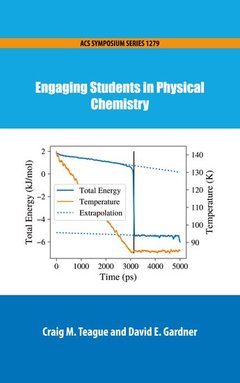Description
Engaging Students in Physical Chemistry
ACS Symposium Series
Coordinators: Teague Craig M., Gardner David E.
Language: English
Subject for Engaging Students in Physical Chemistry:
Publication date: 06-2019
224 p. · 16x23.6 cm · Hardback
224 p. · 16x23.6 cm · Hardback
Description
/li>Biography
/li>
As a discipline, physical chemistry has earned a reputation among students for being difficult and challenging. Unfortunately, many students over the years have come to view physical chemistry as worse than simply being difficult; they have come to view it as boring, dull, and not very relevant. However, there is a growing interest in improving physical chemistry instruction with a focus on student engagement and learning. The authors in this book come from across the country and represent schools of all sizes. From both classical and statistical thermodynamics to kinetics and quantum mechanics, from computational simulations to spectroscopy and chemical education, the authors present ideas from a wide cross-section of physical chemistry. there is not a single, one-size-fits-all approach to engaging students in physical chemistry. This book reflects the diversity of physical chemistry experiences of the authors themselves. Some chapters provide suggestions to increase engagement by providing new, intriguing contexts such as protein interactions and surface chemistry through which to teach traditional physical chemistry concepts. Other chapters focus on pedagogy, presenting ideas on how to increase the active involvement of students in their own learning or how to help students memorize difficult thermodynamic equations. Still other chapters challenge traditional instructional notions with ideas such as using flipped classrooms and incorporating a graphic novel. In general, we organized the chapters according to these broad categories, although some chapters bridge categories. In short, this book is not so much a step-by-step instruction manual as it is a resource for ideas, guidance, and inspiration for improving your own physical chemistry curriculum for the purpose of engaging students.
Craig M. Teague obtained a B.S. from Missouri State University with a double major in physics and chemistry. He obtained a Ph.D. in chemistry from the University of Illinois at Urbana-Champaign. Since 2003, he has taught at Cornell College in Mount Vernon, Iowa. He is now a full professor and department chair. He has served as visiting faculty at Oak Ridge National Laboratory on multiple occasions. David E. Gardner obtained a B.S. in physics with a minor in chemistry from Carnegie Mellon University. He pursued chemistry graduate work at Purdue University where he earned a M.S. in physical chemistry working on combinatorial methods for hydrothermal zeolite synthesis. His Ph.D. in chemical education examined the difficulties students encounter while learning quantum mechanics. Since 2002, he has taught at Lander University in Greenwood, South Carolina.
© 2024 LAVOISIER S.A.S.
These books may interest you

Basic Chemical Concepts and Tables 160.25 €



